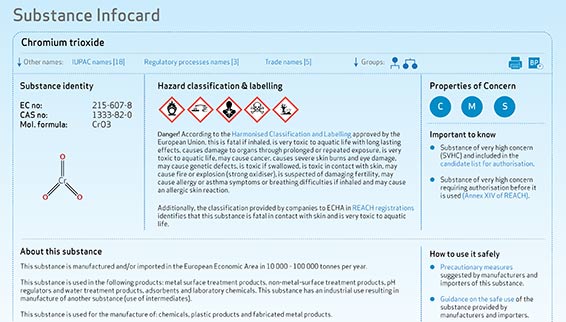Effects on aquatic life
We limit the emissions but many chemicals used today still end up in our environment and in lakes, rivers and oceans. Most chemicals cause no harm but not surprisingly, chemicals that are harmful to humans may also be harmful to the environment and to the animals that live in aquatic ecosystems.

Here in Europe, most of us take clean water, fresh air and unpolluted nature for granted. Yet the reality is that hazardous chemicals can be released into our natural environment if they are not properly controlled. These toxic substances can damage fish and wildlife and result in long-term ecological effects.
What is the EU doing?
In addition to requiring substances to be classified as dangerous and labelled to enable consumers and workers to use them safely, the EU takes stronger measures where the risks are unacceptably high.
An example is epoxypropyl neodecanoate (EPDA) which is used in paints, varnishes, adhesives and construction materials. It is mainly used by workers but it can also be found in coating products for consumer use such as wood varnishes and paints.
Based on the evidence, we now know that it is toxic to aquatic life, is suspected to cause genetic defects in children and may also cause allergic skin reactions.
This has led to EPDA being classified as a mutagenic substance – meaning that it may damage our genes. When a substance is so hazardous, companies producing, importing or using it must abide by strict rules to protect the environment and workers. For example, there are strict rules for the packaging of EPDA, which has to clearly indicate the hazards of the substance. With more information, employers and workers are able to better protect themselves and minimise any harm to the environment including aquatic life when handling the substance.
Protecting surface water wildlife
Another concrete example is nonylphenol ethoxylates (NPEs). They are substances that are used in some textiles and pose a risk to the environment, especially to aquatic species living in surface water. They are released into the environment during washing of textiles. NPEs are used in clothing but also different kinds of accessories, interior textiles, fibres, yarns, fabrics and knitted panels.
Because of the harm to the environment, the substance group is restricted under REACH and is not allowed to be put on the market over a certain threshold after 3 February 2021 in textiles that are expected to be washed in water.
Environmentally-friendly alternatives
Protecting the environment from pollution is one of the key reasons for having the REACH Regulation. Encouraging industry to use substances in a controlled manner and to substitute hazardous substances with less harmful ones is a top priority for ECHA and REACH.
Hydrocarbon solvents are substances that are used in everyday products such as paints and tyres. Unfortunately, they can also affect the environment and human health. One company has been researching environmentally-friendly alternatives to traditional hydrocarbon solvents under the research and development exemption in REACH.
Their research has resulted in new substances that are less persistent in water and are also likely to be biodegradable. These new, more environmentally-friendly alternatives, are being marketed to companies that want to reduce their impact on nature.
In Europe we also have a Water Framework Directive that collects all the environmental legislation and ensures that we have a clear objective for clean waters. If you are interested, you can read more about the legislation following the link below.
Read more
- Information on chemicals
- European water policy - European Commission
- Introduction to the new EU Water Framework Directive - European Commission
Read Also
-
 Products
ProductsClothes and textiles
There are many ways we come into contact with textiles in our everyday lives – the clothes we wear, the bed linen we sleep in, the towels we dry ourselves with and the furniture we sit on. Chemicals are added to these products for various reasons to improve them, but in some people they can cause troublesome health effects, including allergies.
READ MORE -
 general
generalSearch for chemicals
Have a look at our unique database to find out more about chemicals used daily in Europe.
READ MORE
